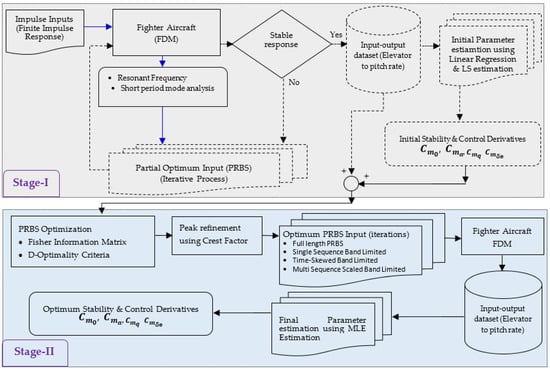1. Introduction
Aircraft System identification provides a platform for the mathematical mapping of a more accurate and robust dynamical model of the aircraft, predicting stability and a control mechanism, and leading to efficient and effective refinement in performance measures. Two approaches are generally adopted for input design; the first is a ‘wide frequency’ range with ‘constant power’ across the complete spectrum; and the second is the input with a specific ‘tailored frequency’ for the aircraft. The broad range includes frequency sweeps and impulse inputs. The second category, input with customized frequency, also referred to as optimal input, is designed as per the dictates of aircraft aerodynamic characteristics, in-line with its natural frequencies. This includes doublets, square waves, and multi-sine inputs [
1,
2]. In the system identification, an optimal input design remains unique for every set of problems [
2], and a customized input for one problem cannot be optimum for any other problem. Our research focuses on discovering a discrete-time, open-loop, longitudinal dynamic model of supersonic aircraft (F-16), using a two-staged optimal input. Therefore, binary periodic inputs with complete control over excitation amplitudes have been chosen [
2]. A novel algorithm for multi-stage input optimization has been proposed in this paper, and it demonstrates the stepwise refinement of the input by optimizing PRBS parameters as per aircraft spectral features obtained from the non-parametric model estimation, i.e., FIR, further second stage refinement of frequency, amplitude, order, and periodicity, by maximizing the Fisher Information Matrix by using D-optimality and crest factor.
In
Figure 1, the research framework is presented in two colored boxes, as follows: Stage-I (gray color) and Stage-II (blue color). Stage-I sets the foundation for partial optimum PRBS input and Stage-II formulates the fully optimum PRBS input. The dashed boxes and arrows represent the initial values, iterations, processes involving the input–output dataset, parameters, and PRBS inputs; whereas the continuous solid lines indicate the final values, iterations, and processes of the same elements. The blue-colored arrows in Stage-I indicate the FIR modelling cycle. The FIR model, by definition, extracts the finite impulse response characteristics (damping rate, input–output delays) of the aircraft dynamical system within a specific time window, as the output becomes zero after a finite duration [
2]. The FDM of F-16 aircraft used in this optimization process has been acquired from Stevens et al. [
3].
In Stage-I (gray box), the spectral characteristics of the fighter aircraft (F-16) FDM are discovered by using non-parametric modelling (FIR), i.e., natural frequency, desired input pulse-width, and short-period mode analysis (blue arrows). This dynamical behavior, coupled with aircraft constraints, further leads to the design of the initial PRBS input parameters, i.e., frequency (
), amplitude (
U), order (
n), and sampling periodicity (
Np), through an iterative process. The obtained partial optimum PRBS input is further utilized to excite the aircraft FDM, to acquire the SISO input–output database. Since the research only focuses on longitudinal dynamics, the PRBS input is given as an elevator (
δe) input to the FDM, and the output in the form of pitch rate (
q) is recorded through successive iterations (necessitating stable response from the FDM). This input–output dataset is used to postulate the initial parameters (stability and control derivatives of longitudinal dynamics,
) by using Linear Regression and LS estimation. The PRBS obtained in Stage-I is considered to be partial optimal, as the constant nature of the PRBS amplitude causes over-parameterization or misspecification of the dynamical model [
1]. To tackle this issue, further optimization of the PRBS input parameters is needed, thus leading this research to Stage-II optimization (blue box).
In Stage-II (blue box), Fisher Informative Matrix (FIM) and Crest factor, coupled with D-optimality criteria have been utilized to acquire plant friendly PRBS input with its optimal parameters i.e., frequency (), amplitude (U), order (n) and sampling periodicity (Np). To address this problem, input-output dataset as well as a priori longitudinal aerodynamic parameters (stability and control derivatives) obtained in Stage-I are utilized with FIM having D-optimality criteria; further fine-tuned through Crest Factor mechanics. Optimized PRBS input parameters (, U, n and Np) are implemented on four different PRBS types i.e., Full length PRBS, Single Sequence Band Limited PRBS, Time-Skewed Band Limited PRBS and Multi Sequence Scaled Band Limited PRBS. Comparative analysis of each of the PRBS input is conducted using statistical tools (Residual analysis, Standard errors, t-statistics, fit error and coefficient of determination ). Finally, ‘Optimized PRBS’ is selected, which excites aircraft FDM, to postulate most accurate longitudinal model parameters using non-linear estimation technique, i.e., Maximum Likelihood Estimation (MLE).
Designing optimal inputs is more crucial for fighter aircraft due to fast maneuvers and intricate flight constraints. Maximum informative inputs obtained using two-staged optimal algorithm although takes a larger effort than single stage optimization, however, it becomes justified, as accurate model parameters and efficient experimental design cannot be attained without these optimized inputs. Overall contribution of this research is getting accurate SISO longitudinal aerodynamic parameters (stability and control derivatives) using optimized PRBS inputs, thus improving robustness in existing flight controller design of ground based simulator, future modifications, and understanding pilot-aircraft interactions during emergencies.
1.1. Related Works
Considerable attention for optimal input design emerged in mid 1960s to early 70s [
4,
5,
6,
7,
8,
9,
10] for dynamical systems in general, and aircraft system identification in specific, to estimate aerodynamic stability and control derivatives. Problem for solving optimum input remained well researched in statistics literature, however, initially in engineering community, it mainly revolved around maximizing signal to noise ratio, natural frequency criteria, FIM and its associated alphabetical optimality criteria [
1,
11]. Klein and Morelli in their book [
1] elaborated theory of experiment design and its sub-specialty input design; emphasizing on optimal inputs that includes doublets, square wave and multi-sine inputs. Such techniques mainly utilize single-stage optimization based upon aircraft practical constraints, scalar criterion, switching time scales, frequencies and amplitudes.
Eugene A. Morelli [
12] has recently contributed tremendously towards building theoretical concepts underpinning optimal input design for aircraft system identification. Author has drawn comparison between heuristic inputs (used with a priori model) with orthogonal optimized multi-sine inputs (without any prior model knowledge). Where the later technique produces more robust models, however, often yields degraded results due to low SNRs and coarse frequency resolution, resulting in an iterative process design. Earlier, multisine orthogonal inputs with frequency responses were also demonstrated by Grauer et al. [
13] using numerical implementation on T-2 airplane and promising results were achieved. However, working in frequency domain poses a problem of disconnection with physical analysis of the plant being studied and may be conducted well in time domain for efficient results [
1].
Further categorizing the type of optimal inputs for high-speed airborne vehicles, Morelli [
14], explained five different characteristics of optimal inputs such as: Multiple simultaneous inputs, orthogonal inputs, wide band frequency content, small excursions and perturbation inputs. Among them, most popular and widely used for system identification are wide-band frequency content using PRBS inputs due to its lowest crest factor [
2]. Morelli et al. [
15], research on orthogonal optimized multisine inputs, has been most recent and wholesome contribution to optimal input design for aircraft system identification. Although such inputs are ideal for complex MIMO systems, however, present some sensitivities related to selection of phase angle and power distribution. Alternatively, for SISO problems, simpler solutions using optimized time-domain band-limited PRBS inputs, having similar wide-band frequency characteristics with ease of generation needs exploration.
In a recent study by Ghoreyshi et al. [
16], optimal input design for a generic fighter configuration aircraft has been analyzed. Among a class of inputs (chirp, Schroeder, PRBS, random, and sinusoidal signals); PRBS predicted most accurate models for pressure data of the aircraft. In further optimization of input design, Jana et al. [
17] effectively utilized FIM for optimization of input signals by deriving a relation between model shape components and FIM. Hosseini et al. [
18] obtained robust optimal input design by using dynamic programming and injecting uncertainties to depict practical constraints while designing the inputs, as generally input designs are made by considering an ideal aircraft structure and environment. Lichota et al. [
19] optimized input signals using D-Optimality Criterion (maximizing the determinant of the FIM) with use of genetic algorithm. Optimal inputs were found to produce better results than traditional multistep inputs (doublet and 3-2-1-1). In the last decade, substantial contribution has been made in optimal input in aircraft system identification [
20,
21,
22,
23,
24,
25,
26] and its implementation on air-borne vehicles [
27,
28,
29,
30,
31] with an aim to accurately acquire informative content from aircraft. Other than aircrafts, optimal inputs using PRBS has also been successfully used by [
32,
33,
34,
35,
36,
37]. Summary of key studies in optimal input design has been presented in
Table 1.
1.2. Research Contribution
Contribution of this research is two-fold; the first one is novelty of technique, for devising a two-stage input optimization of discrete time PRBS signals as per aircraft characteristics coupled with FIM and D-optimality criterion, further refined with Crest factor theory. The second one resides in implementation of optimized PRBS input on fighter jet supersonic aircraft (simulated F-16 FDM) to calculate its longitudinal stability and control derivatives. Proposed algorithm and its implementation scheme is a ready-made solution that can be applied to any fighter jet for obtaining its parameters and further utilized to improve flying quality assessments, improving controller robustness and designing ground based simulator. In continuation to key studies and major contributions towards optimal input design (
Table 1), this work presents a simpler, efficient and unique solution towards postulating an accurate model for longitudinal stability and control derivatives of an agile aircraft in time-domain.
1.3. Paper Outline
Paper has been divided into four sections.
Section 2 gives an account of optimal input preliminaries as per aircraft flight dynamics and structural constraints.
Section 3 gives a detailed account of methodologies containing algorithms and techniques towards designing two stage optimal inputs.
Section 4 gives results and analysis. Lastly, conclusion has been presented to give wholesome view of the paper, leading towards possible future research work.
5. Conclusions
The problem of designing optimal PRBS input in time-domain for system identification of LTI SISO longitudinal dynamical model of supersonic aircraft has been solved using a novel two-stage optimization approach. The element of novelty resides in designing a unique stage-wise optimal PRBS input and its further implementation in determining coefficients of pitch moment (stability and control derivatives) of a supersonic aircraft. Stage-I optimization of PRBS input was obtained using a priori knowledge of the aircraft, its spectral features, aerodynamic constraints and minimization of a scalar cost function. PRBS parameters such as frequency (), amplitude (), order (n) and sampling periodicity (Np) were optimized in first stage. In stage-II, Fisher Information Matrix with D-optimality criteria coupled with crest factor were utilized for achieving fully optimized PRBS input parameters. After attaining optimized PRBS input, time histories of input-output dataset were utilized to determine stability and control derivatives of pitch moment coefficient using MLE technique. A statistical approach was adopted for validation of results using Coefficients of Determination, t-statistic and fit error.
Four different classes of PRBS inputs were made part of our investigation; to select a PRBS type, best suited for identification of supersonic aircraft longitudinal model. Single Sequence Band limited PRBS gave best fit results with coefficient of determination of more than 95%. While drawing comparisons, no significant difference was observed between Single Sequence and Time Skewed Band limited PRBS inputs, however, Single Sequence was considered more suitable due to principle of parsimony (lower PRBS order and lesser amplitude involved). However, one of the limitations of using this algorithm with constant amplitude PRBS, may cause mis-specification and may be dealt using Amplitude-Modulated (AM) PRBS. For future research, same approach can be validated for lateral-directional dynamics of aircraft with modified PRBS inputs such as Multi-valued PRBS and AM PRBS for MIMO systems.


